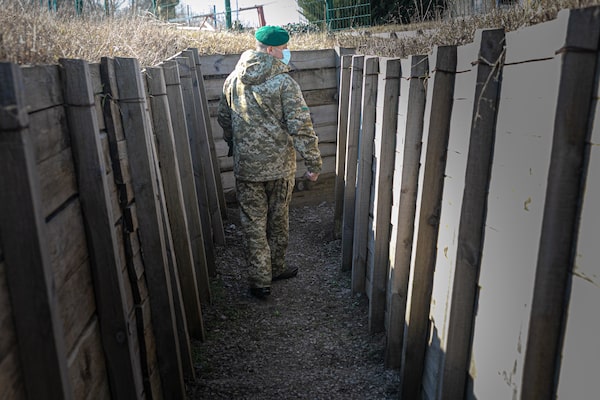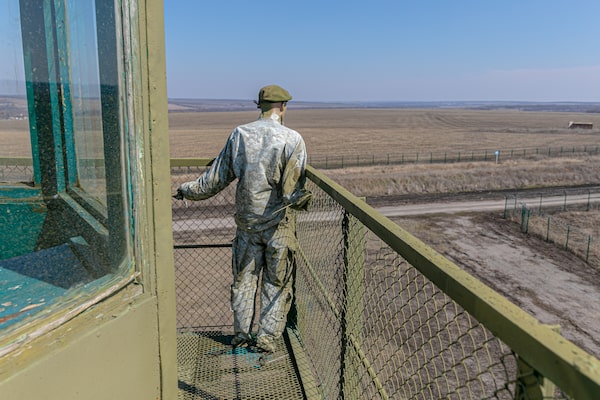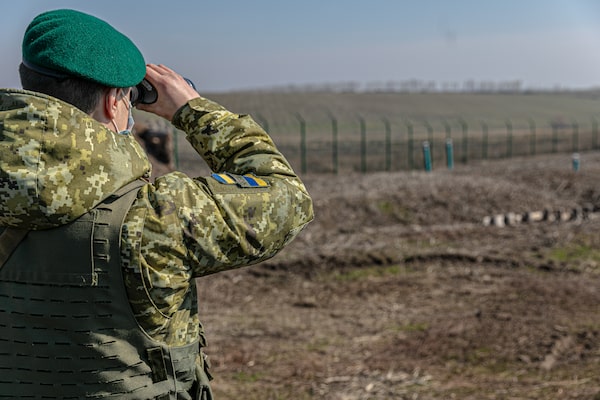
Colonel Valeriy Vavryniuk inspects some trenches at a border station near Kharkiv in eastern Ukraine. Fortifications like this were once unknown here, but now the frontier with Russia is heavily guarded.Photography by Anton Skyba/The Globe and Mail
Walking through wooden-walled trenches dug along Ukraine’s northeastern border, Valeriy Vavryniuk, a colonel in the country’s Border Guards, brushes aside a question about whether the massing of Russian troops on the other side means war is coming. “War is already here,” he says solemnly. “The war started seven years ago.”
The jagged lines of trenches, pillboxes and pre-dug tank positions stitched through brown farmers’ fields are a reminder of how much has changed in the Russia-Ukraine relationship since 2014, when Moscow seized and annexed Crimea, and sent troops to aid a separatist uprising in Ukraine’s Donbass region, just south of the area that Col. Vavryniuk commands.
A border that was once casually marked by a few signs and customs booths is now one of the most fortified places in Europe, demarcated on the Ukrainian side by the new battlements, as well as a green metal fence topped with barbed wire and dozens of surveillance cameras.
But, Col. Vavryniuk acknowledges, all of it would serve only to slow down a Russian advance if the proxy war already waged by Moscow against Kyiv turns into an all-out invasion. There are multiplying signs that Russian President Vladimir Putin is at least contemplating such an escalation, after a weeks-long build-up that has brought an estimated 85,000 Russian soldiers to within a short drive of Ukraine’s borders.
“The closest concentration of Russian forces is 40 kilometres from here,” Col. Vavryniuk says, staring across muddy fields that in summer will yield crops of wheat.

Col. Vavryniuk says the border fortifications might only help to slow down a Russian invasion.
The tensions at the border have become an increasingly urgent international issue in recent days. On Tuesday, NATO Secretary General Jens Stoltenberg called on Russia to “end this military build-up in and around Ukraine, stop its provocations and de-escalate immediately.”
Russian Deputy Foreign Minister Sergei Ryabkov, meanwhile, said it was the U.S. that was behaving provocatively by sending two warships into the Black Sea near Crimea. “We warn the United States that it will be better for them to stay far away from Crimea and our Black Sea coast. It will be for their own good,” Mr. Ryabkov said.
Later in the day, U.S. President Joe Biden held a call with Mr. Putin. The White House said Mr. Biden called on Mr. Putin to de-escalate tensions around Ukraine, and proposed a summit meeting in a third country “to discuss the full range of issues facing the United States and Russia.”
The name of the border outpost Zvyazok means “connection” and speaks to how close Ukraine and Russia once were. The hamlet was named for the telephone lines that ran through it, connecting citizens of the two countries when both were member republics of the Soviet Union.
Today Zvyazok is a place of division, with the green metal border fence zigzagging around the hamlet’s wooden homes. The two dozen people who live here are frequently outnumbered by border guards nervously scanning the surrounding territory for signs of enemy activity. While many in the Ukrainian capital of Kyiv – 500 kilometres to the west – are dismissive of the possibility of a wider war, the mood is understandably more anxious on what could rapidly become a frontline.

A surveillance team monitors the Russian side of the Goptivka border crossing, north of Kharkiv.
During a tour of the frontier arranged by the State Border Guard Service of Ukraine, The Globe was encouraged to speak to the ordinary soldiers who are the country’s first line of defence.
When asked if he was worried about war, one young soldier just exhaled into his face mask and spent a long moment searching for words before his commanding officer intervened.
“As a resident of Ukraine, obviously he is concerned because he has relatives and family here,” said Lieutenant-Colonel Sergey Makarov.
“You’ve heard about the wall,” interjects Col. Vavryniuk, referring to how Ukrainian media describe the metal border fence. “These guys are the real wall, not that fence.”
It’s bravado, meant to bolster the morale of the troops who are still in earshot.
In more private conversations, Col. Vavryniuk admits the border guards – he says he has “a few thousand” under his command along the eastern frontier – know they are only there to hold the line until Ukraine’s regular army arrives. That’s if it’s not already occupied elsewhere.

A plastic dummy looks out from a watchtower, a warning against illicit crossings. A CCTV system also monitors the border.
Ukraine has the third-largest army in Europe, with 200,000 active soldiers. But its capabilities are stretched thin by seven years of low-level combat in the Donbass region, which has been under the control of Russian-backed separatists since 2014. Russia, which has a standing army of just over a million soldiers, is also massing troops to Ukraine’s south, in the occupied Crimean Peninsula. It also has troops stationed to Ukraine’s west, in the breakaway Transdniestr region of Moldova. Belarus, on Ukraine’s northern border, also hosts Russian forces on its soil.
Fears that Mr. Putin may be about to order a fresh offensive against Ukraine skyrocketed this week when a Russian delegation failed to attend an emergency meeting of the Organization for Security and Cooperation in Europe, a 57-country grouping, where Ukraine and its allies had hoped for an explanation of the Russian military movements. Ukrainian President Volodymyr Zelensky’s office later revealed that it had requested a phone call with Mr. Putin to discuss the situation, but received no reply.
With Russia refusing to explain its troop movements, pundits are left guessing at Mr. Putin’s motives and intentions. Some believe he is keen to test Mr. Biden, to see where the new administration’s red lines are (with China simultaneously doing the same around Taiwan). Others see the Russian military build-up as intended to influence politics inside Ukraine, where Mr. Zelensky recently moved to shut down three Russian-language television stations and to impose sanctions on their owner Viktor Medvedchuk, an oligarch who is a personal friend of Mr. Putin’s.
Mr. Putin has his own domestic problems, including one of the world’s highest per-capita death rates from the COVID-19 pandemic, as well as protests over the arrest of opposition leader Alexey Navalny in January. But Sergey Markov, a Moscow-based political analyst and occasional Kremlin advisor, dismissed the idea that Moscow was responsible for the crisis. He said Russia was only responding to provocations from Ukraine and the Biden administration.
Mr. Markov accused the White House, and particularly Secretary of State Antony Blinken, of pushing Ukraine to take a more confrontational approach toward Russia, which in recent weeks has included calls from Mr. Zelensky for Ukraine to be offered a swift path to membership in the NATO military alliance.
“Blinken first and Biden as well want to show Putin that they are real strong guys,” Mr. Markov said in an exchange of messages with The Globe. He said public opinion in Russia demanded that Mr. Putin respond to any Ukrainian attacks against Russian speakers in the separatist-controlled areas of Donbass.

Colonel General Ruslan Khomchak, shown at his Kyiv office, is head of Ukraine's armed forces.
In an interview with The Globe, the commander-in-chief of the Ukrainian armed forces, Colonel-General Ruslan Khomchak, said comments such as Mr. Markov’s were part of a propaganda offensive Russia was already waging against Ukraine. He said the real problem was Russia’s refusal to accept that Ukraine was now a fully independent country, capable of making foreign policy choices – including its aspiration to join NATO.
The quantity of Russian troops in the border areas weren’t sufficient from a strategic point of view to mount a full-scale invasion, according to Col.-Gen. Khomchak. But his forces were bracing for a range of scenarios, including the possibility that Mr. Putin would order some kind of operation to seize control of the North Crimean Canal, which lies 90 kilometres north of the current frontier.
Russia, which seized and annexed Crimea after a pro-Western revolution in Kyiv, has struggled ever since to supply the territory with water. Ukraine retaliated to the annexation by damming the Soviet-built canal, which supplies the peninsula with 90 per cent of its fresh water.
“I consider water not to be the real issue or the real casus belli, but Russia may use the water issue as the pretext,” Col.-Gen. Khomchak said, speaking inside the Soviet-built Ministry of Defense headquarters in Kyiv. “There are water issues in plenty of countries all over the world, and they are solving them without invading.”
Col.-Gen. Khomchak said the most likely scenario remained an escalation in the Donbass region, since Russia could claim – as it did in 2014 – that any new offensive was being carried out by “separatists” beyond its direct control. “In those areas, Russia can bring up their forces, just remove their epaulettes, and claim that ‘we have no soldiers there.’”
After a period of relative calm during the last six months of 2020, fighting has surged again in 2021, with at least 30 Ukrainian soldiers killed since the start of the year. Col.-Gen Khomchak said the escalation was likely an effort to pressure the Ukrainian side into implementing the terms of a 2015 ceasefire agreement known as the Minsk Protocols.
Those agreements, which were negotiated largely on Russian terms as Ukraine faced threat of losing more territory, call for the Donetsk and Lugansk regions to be reintegrated into Ukraine with special autonomous status that would allow them to veto national policy decisions, such as a move to join NATO. The terms were always unpopular in Ukraine, and successive governments have been slow to implement them, foot-dragging that Russian analysts say has helped lead to the current crisis.
“In recent years, we have seen a clear correspondence between the amount of shelling, and pressure on our high political officials, in order to force them take certain decisions,” Col.-Gen. Khomchak said. “Generally speaking, the prime goal of the Russian Federation is not to lose Ukraine from its own sphere of influence. Today, several prominent Kremlin leaders cannot deal with the fact that the Soviet Union collapsed, and the newly independent states can decide their own business.”

A woman crosses into Russia at the Goptivka crossing, which is mostly empty because of the escalating international tensions and the COVID-19 pandemic.
Back in Zvyazok, Col. Vavryniuk says his troops are on the lookout not only for major Russian troop movements, but also for smaller-scale efforts to try and cross the border. Cross-border infiltrators played a major role in stirring up separatist sentiment in the cities of Donetsk and Lugansk in 2014, both of which have since declared themselves to be independent “people’s republics.”
A similar effort in Kharkiv – Ukraine’s second-largest city, and just 40 kilometres from the border at Zvyazok – failed, but only after a series of clashes between pro-Russian and pro-Ukrainian groups. The Russian flag was briefly raised over the regional administration building in the city centre.
Kharkiv residents say the Russian military build-up has created fears that the events of 2014 could be repeated. “There’s anxiety in the city,” said Natalya Slyusar, a local entrepreneur. “There’s a fear that there will be more instability.”
But Ms. Slyusar said pro-Russian sentiment in the city had declined in Kharkiv over the past seven years, as residents saw how the events of 2014 had left Donetsk and Lugansk economically and politically isolated, in addition to the semi-constant fighting. Mykhailo Kamchatnyi, a Kharkiv-based political analyst, estimated that if a third of Kharkiv residents were pro-Russian seven years ago, that level was closer to 15 per cent today.
Col. Vavryniuk says his forces were aware of the possibility that Russia would again try and send provocateurs across the border into cities like Kharkiv. He said the Border Guards were also aware that Russian forces could try to draw them into overreacting to a small provocation – like a mid-March incident that saw a Russian military helicopter briefly cross into Ukrainian airspace – with the intent of justifying a preplanned invasion.
One politician who feels he’s seen this all happen before is Mikheil Saakashvili. In 2008, he was president of Georgia when fighting flared up in and around South Ossetia, a region of Georgia which, like Donbass, is under the control of Russian-backed separatists. Georgia then, like Ukraine now, publicly pushing to join NATO.
After a weeks-long build-up of Russian troops near the country’s border with Georgia – under the auspices of a military exercise – South Ossetian forces began shelling Georgian territory in the summer of 2008. Mr. Saakashvili ordered Georgia’s army to move into the separatist-controlled region, triggering a 12-day war that saw Russian troops retake South Ossetia, then push deep into Georgian territory before a French-brokered ceasefire was enacted. In the aftermath, Russia recognized the independence of South Ossetia and Abkhazia, another breakaway region of Georgia.
Mr. Saakashvili is now in Kyiv and advising Mr. Zelensky on how to handle the current crisis. He said he saw a “very strong parallel” between the build-up to the 2008 war and what was happening now along the Russia-Ukraine border.
“So far we see every sign of preparations for war,” Mr. Saakashvili said in a telephone interview. He said he saw the escalating confrontation as Mr. Putin testing the new White House to see how they would respond.
“Russia always raises the stakes, knowing the West will not follow suit,” Mr. Saakashvili said. “I’m not sure Biden is ready for concrete military measures – and nothing short of military contact is going to stop Putin.”

A guard at the Kharkiv border units looks out toward Russia.
Our Morning Update and Evening Update newsletters are written by Globe editors, giving you a concise summary of the day’s most important headlines. Sign up today.
 Mark MacKinnon
Mark MacKinnon